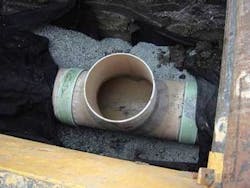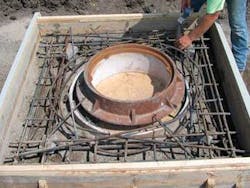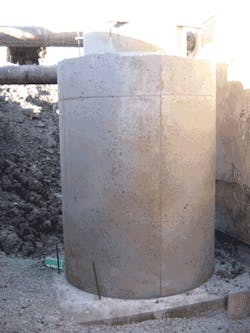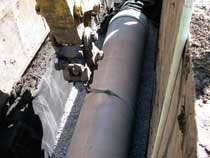The “Gravi-Force” Is With You: Using Gravity to Optimize Costs
by M. Kent Prior, Scott Aurit and Brian Kramer
The City of Lincoln, NE, is growing, and its infrastructure systems are not keeping pace in critical community areas. The Lincoln Wastewater System (LWWS) developed a strategy to accelerate utility infrastructure development, nearly doubling the rate for affected areas. The utility determined that the most critical need was to upgrade the wastewater collection system to prevent overflows now and in the future. A secondary need is a system that will accommodate future wastewater flows resulting from development to full build-out capacity.
In conjunction with the Lincoln-Lancaster County Comprehensive Plan, LWWS developed a Wastewater Facilities Master Plan to proactively address wastewater issues. These plans identified future utility needs for 25 years (Tier I) and 50 years (Tier II), using population projections provided by the Lincoln-Lancaster County Planning Department.
The project started when LWWS issued an RFP. HDR was selected based on its innovative approach to designing the North 31st Street Lift Station Outfall Improvements, a vital part of the system. HDR’s design proposal was to construct a “gravi-force” main to achieve the full range of capacity with a single, cost-effective project.
HDR presented two alternatives as a solution to the systems capacity problem. Alternative one, for a single gravity outfall sewer along with the existing sewer, could meet existing flow capacity requirements. The gravi-force concept allows the new 36-inch sewer main to operate under gravity flow conditions until 2024 when flows become greater than its capacity and then become a force main to create additional capacity.
Analyzing Alternatives
The gravi-force concept alternative was analyzed utilizing the existing 24-inch force main beneath Salt Creek to delivery flows for Tier I to a new diversion structure which would be constructed to replace the existing receiving manhole. The diversion structure would spit flows between the existing 24-inch gravity sewer and a proposed new sewer. A new 36-inch sewer would then extend south along an abandoned railroad right-of-way, where a second diversion structure would be constructed to convey flow to either of the existing 30- or 42-inch trunk sewers. A second 24-inch force main would need to be constructed in approximately year 2036 beneath Salt Creek to convey Tier II flows to the diversion structure and through the existing 24-inch gravity sewer and proposed 36-inch gravi-force sewer.
A second alternative for a force main was analyzed that would use the existing 24-inch force main beneath Salt Creek for Tier I flows. A new 24-inch force main would connect to the existing force main and extend south along the abandoned railroad right-of-way to a diversion structure that would be constructed to convey flow to either the existing 30- or 42-inch trunk sewer. A second 24-inch force main would be needed in approximately year 2015 from the lift station to the existing 30-inch trunk sewer to convey Tier I and Tier II flows.
Alternative two would require a new 24-inch force main immediately and a second 24-inch force main in the future. LWWS chose alternative one for the gravi-force sewer.
As population growth occurs within a service area, upgraded and expanded facilities are required to meet service needs. The timing associated with future system improvements within each drainage basin depends on the rate of development within the basin. An important part of the project, the Little Salt Creek drainage basin, is a growing service area, which includes over 3,000 acres of developed land and will ultimately be 5,300 acres in all.
In addition, several capacity-related problems existed with the current collection system downstream from the 31st Street Lift Station.
The design eliminated the need to construct a parallel gravity sewer or force main now, followed by a third in the future, which would be in a more congested area and at an inflated cost. The ‘gravi-force’ main project solution accomplishes the same effective result with only a single project constructed now that delivers a substantially lower life cycle cost. A single larger gravity flow system was not considered due to the congested area and the presence of other utilities.
Based upon the parameters evaluated, a new outfall sewer could be constructed to convey flows along the abandoned railroad property and along State Fair Park Drive right-of-way to the existing 30- and 42-inch trunk sewers. This route would maximize utilization of the existing capacity in the 30- and 42-inch trunk sewers and eliminate the need to have a new sewer constructed to convey flow all the way to the Theresa Street WWTF. The higher elevation of the railroad grade provided sufficient cover and permitted pipe slopes needed to move the flows into the existing 30-inch trunk sewer.
Only Pressure Rated Options
LWWS considered only pressure rated products for the line, which would ultimately operate as a low-head force main system. The specified pipe options included Hobas CCFRPM, PCCP, SW-HDPE and C-905 PVC. The installation contractor, Roloff Construction Co., of Omaha, NE, chose Hobas because of its overall economic advantages, the 20-foot joint lengths and its simple gasket sealed joint.
A direct bury project like this one needed a simple slip joint. Once the line was installed, the pipe was tested. The air test held so well that the team decided to plug the manholes and test up to 2,000 linear feet at a time. The entire line was pressure-tested to six psi for two hours without a single leak or pressure drop.
Lowest Total Cost
HDR developed capital costs for the sewer alignment alternatives. Alternative two provided the lowest project cost to meet the current need, however, this would not have delivered the lowest life-cycle cost. To determine the lowest life cycle for the project, LWWS believed it was necessary to use a projected growth rate, projected flows and an estimate of the present value of both alternatives. The calculations, based on present values, showed that the gravi-force sewer option would have an overall saving of $300,000 compared with the force main option.
The project is now completed, and the complete construction cost was approximately $1.5 million. Savings resulted primarily from not having to install a new sewer 20 years down the road. Since major redevelopment will occur in this area for the next 10 years, the $300k is likely an understatement of total cost savings. The project was completed within the CIP budget the city set for the first sewer project, providing a 50-year solution for the cost of one project versus two planned projects.
Apparently, this is the first identified application for the gravi-force concept. The authors could not find other documented instances where a utility had designed specifically for this concept. Construction was begun in 2005 and completed within nine months and the sewer is operating successfully.
About the Authors:
Kent Prior, P.E., is a senior project manager based in HDR’s Lincoln office. Scott Aurit, P.E., is a project engineer based in HDR’s Omaha office. Brian Kramer, P.E., is an engineer with the city of Lincoln Wastewater System.




